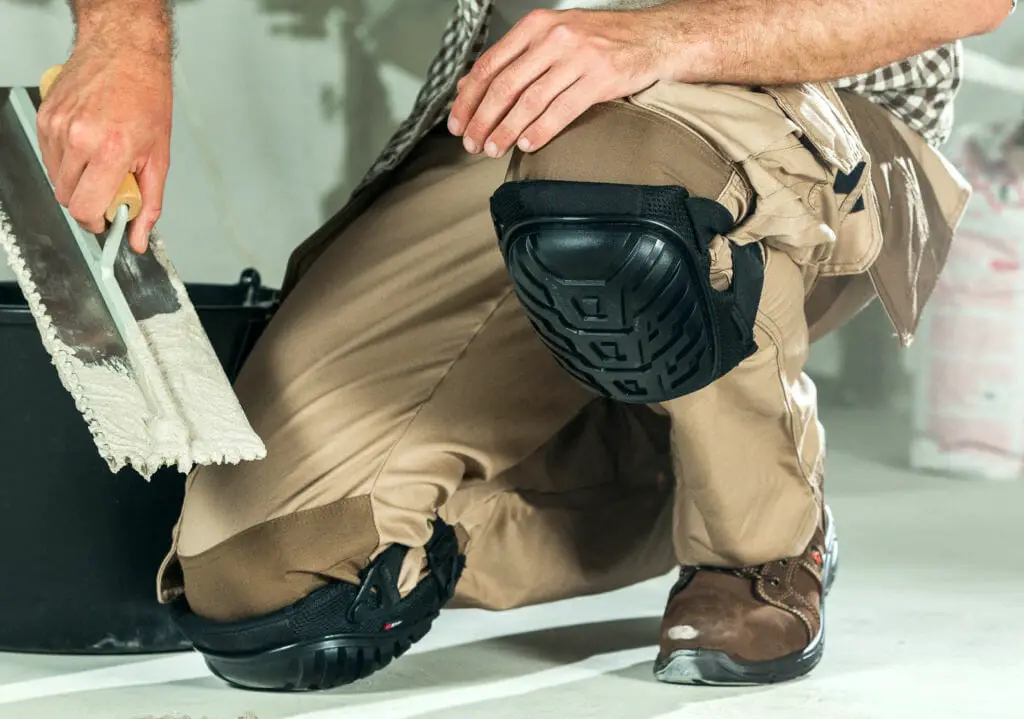If you are a construction worker, you know how much work your knee has got to do the entire day because the scratches and pain in the knee joints tell it all at the end of the day!
But you should know the correct way of wearing a knee pad or it will be of use…
Wear the knee pad just across the upper shin, covering the knees and the upper calf region. It should not stretch too much on the thigh area or else your knee movements will be hindered.

Wear the knee pad while sitting in a position that your knees are bent, that way you will know how to adjust the pads for the proper movements of your knees. Strap the knee pads snugly and wear them over your work pants.
So, that’s how you should actually wear a knee pad, but do you actually need them, if so why and what are the jobs that need wearing a knee pad? This article has got answers to all your queries.
So keep reading…
Why wear a construction knee pad?
The construction site is not safe at all and neither is it for your knees!
You know what your knee has to go through while kneeling on the ground for work, whether for tiling work, or laying the cement, or just doing other work like hammering, loading, unloading objects, etc.
The construction floor is hard, uneven, and full of objects like sharp nails, stones, cement, sand, gravels, glasses, hammers, and various such sharp and hard objects.
So, there is always a chance for your knees to get scratches and cuts from the sharp objects and pain from the hard floor.
Wearing knee pads will save your knees from these cuts, scratches and pains.
This is crucial because your knees are one of the most vital parts of your body. If it gets injured once, it will give you a lifetime pain in your patella joints, difficulty in walking, a short time off from the job or permanent retirement for lifetime because if your legs won’t support you, there will be no work for a construction site!
Knee pads not only protect your knees from injuries, but also give cushioning to the knees so that kneeling and working is no more discomfort for you.
How to wear knee pads the correct way?
Knowing the right way to wear a knee pad is equally important to wearing knee pads because if it’s not worn the right way, the level of protection offered by the pads will be decreased and might be even nil as well and cause discomfort too!
If you think that just wrapping the knee pad around your knees is just what you need to do, my dear friend, you are absolutely wrong as that would decrease the movement of the knee joints and restrict you from bending your knees while sitting on the floor.
The right way to wear a knee pad is just below the knee cap, right on the upper part of the shin. Also, do not wear knee pads just on bare legs, I mean you have to wrap it around your upper shin after wearing a pants or trousers that’s made of a non-slip material.
Also keep in mind that the strap of the knee pad should hold snugly around the upper shin so that it does not restrict your knee movements.
If the strap is too loose, the knee pad will keep coming down while you work and if the strap is too loose, then the knee pad will give you an uncomfortable feel.
Are knee pads meant to be tight?
No knee pads are not meant to be tight at all and you should not tighten them with straps too much. Too tight knee pads will not only give you an uncomfortable feel, it can also restrict blood movement in the legs, swollen your feet, restrict knee movements, and cause blisters in the knee area.
How do I know my knee pad size?
Getting the right size of the knee pad is very important because either of loose and right knee pads will be of no use and cause discomfort and hindrance in your leg movements.
Knee pads generally come in the following sizes:
-
-
- Extra small (10 to 12 inches)
- Small (12 to 14 inches)
- Medium (14 to 16 inches)
- Large (16 to 17 inches)
- Extra large (17 to 20 inches)
-
But how will you know what size knee pad you need?
Well, for that you need to first measure the circumference of your knee area:
-
-
- Wear your work pants above which you are going to wear the knee pads
- Take a measuring tape and wrap it around the upper shin of your legs
- Note the measurement and match with the size measurement stated above
-
When should I wear knee pads?
You should wear your knee before you get down on your knees for work, and if you ask for what type of works should you be wearing a knee pad, then here it is:
-
-
- For plumbing
- For tiling floor
- For cementing floors
- For roofing
- For cutting glass
- For chipping stones
- For climbing ladders
- For bricklaying
- For carpentry
-
What is the difference between knee pads and knee braces?
Most people find this confusing and end up thinking that both of these are the same.
Absolutely not!
While knee braces are prescribed by doctors in order to treat orthopedic disorders related to your knee joints, knee pads are protective gears worn by workers to protect their knees from injuries during work. A knee pad will not correct a disorder, but will prevent that from happening.
How to choose the right construction knee pad?
The perfect construction knee pad should have the following features:
1.) It should have enough cushioning on the knee area because the knees do not have much flesh on them and the cushioning will help take away much pressure from kneeling on the hard floor
2.) The knee pads should be soft enough and should be made of leather. Plastic knee pads will slip off easily while you work
3.) The knee pads should have buckles rather than a velcro because velcros are not durable and can open the straps while you bend your knees by putting too much pressure
And it’s a wrap!
Whether or not your work in the construction site involves putting pressure on the knees, you must still wear a knee pad because as I have said before, the floor of the construction site is full of rough, sharp and hard objects and you never know when you have to kneel down while working.
So, to be on the safer side, wearing a knee pad is safer in order to prevent any unforeseen situation.
That’s all for this post, see you soon in my next article, till then take care and have a great day ahead!







